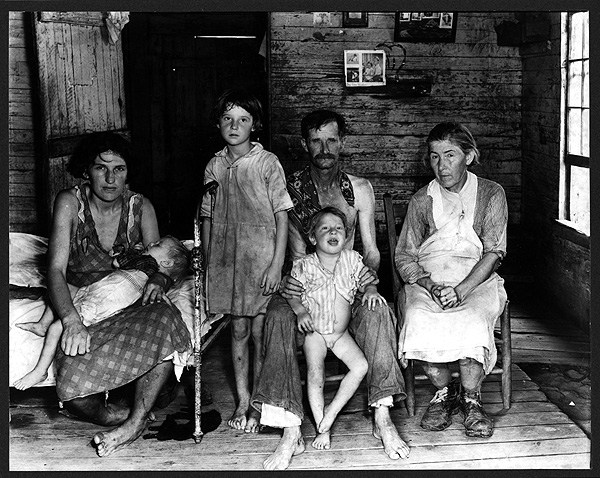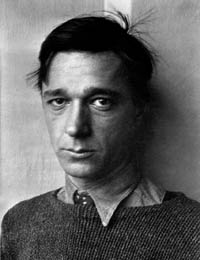Presentation:One Of The Greates Photographers In American
November 3, 1903 - April 10, 1975
In 1922, Walker Evans graduates from
the Phillips Academy, Andover, Massachusetts. He went to study literature at
Williams College only for one year. He decides to work and takes various jobs
in New York City. Walker Evans also had inspiration to become a writer and he
decided to go to Paris to attend literature lectures at The Sorbonne in 1926. He did not last in Paris and return to New York.
He job was a clerk for a stockbroker firm in Wall Street for three years.
In 1928, his first photograph was with
a small hand-held, roll-film camera. In 1930, he published three photographs
(Brooklyn Bridge) in the poetry book “The Bridge” by Hart Crane. This was the
beginning of his career.
In 1936, July to August: three-week stay with sharecropper families in Hale County, Alabama, together with James Agee. The commission is from Fortune for a text-photo article on sharecroppers. Agee had requested Evans as photographer. Evans receives a temporary leave from his Farm Security Administration job under the condition that the photographs become government property. The article was lost. The article did not meet the magazine's expectations and is rejected. The expanded book version does not appear until:
In 1937 September: end of his
contract with the Farm Security Administration. From now on activity as
independent photographer, partially, up to the summer of 1938, for the Farm Security
Administration.
In 1938, "Walker Evans:
American Photographs," exhibition at The Museum of Modern Art, New York,
the first exhibition in this museum devoted to the work of a single
photographer. His picture was featuring in the catalog with an essay by Lincoln
Kirstein. His first photographs in the New York subway with a camera hidden in
his coat.
In1960, New edition of “Let Us Now Praise Famous Men” Walker Evans had expanded section of photographs. The book experiences a late success in the atmosphere of the 1960 protest movements and the beginning of a cult around James Agee. Through this edition a new generation also discovers Evans's photographs.
In1965, he was a professor of photography on the Faculty for Graphic Design at the Yale School of Art and Architecture. The following year he was publication in book form of his subway photographs.
Finally in 1975 April 10: Evans dies in New Haven, Connecticut.
The information was provided...
http://en.wikipedia.org/wiki/Walker_Evans
http://www.metmuseum.org/toah/hd/evan/hd_evan.htm
Final Presentation
Juliet Taymor
She was born on December 15, 1952, in
Newton, Massachusetts, a suburb of Boston. Her father, Melvin Lester Taymor,
was a gynecologist. Her mother, Elizabeth Bernstein, was a teacher of political
science. Young Taymor was fond of international folklore and mythology, and
also developed a passion for theatre. She spent her formative years living in
several countries. As a teenager, during the 1960s, she lived in Sri Lanka and
India with the Experiment in International Living program, then studied acting
in Paris, at the mime school of Jacques Lecoq. From 1969 to 1974, she studied
theatre and mythology at Oberlin College, graduating in 1974 with a degree in
folklore and mythology.
During the 1970s, Taymor lived in Japan, studying the
art of puppetry and Japanese theatre. Then, she spent five years in Indonesia,
working as director of international theatre with Asian, European, and American
actors.
Taymor
directed a massive Walt Disney Company's production of "The Lion
King" and “ Spider-man Turn Off The Dark”, on Broadway, for which she also
co-designed over a 100 costumes and masks of animals, and earned two Tony
Awards Her film, Frida (2002), received six Oscar nominations, and two Oscars,
for make-up and for the music score by Elliot Goldenthal. Taymor continued her
success with the 2004 production of "The Magic Flute" at the
Metropolitan Opera (which is now in repertoires at the Met), and the 2006
staging of "Grendel" at the Los Angeles Opera and, later, at the
Linolcn Center Festival
Taymor directed a massive Walt Disney
Company's production of "The Lion King" and “ Spider-man Turn Off The
Dark”, on Broadway, for which she also co-designed over a 100 costumes and
masks of animals, and earned two Tony Awards Her film, Frida (2002), received
six Oscar nominations, and two Oscars, for make-up and for the music score by
Elliot Goldenthal. Taymor continued her success with the 2004 production of
"The Magic Flute" at the Metropolitan Opera (which is now in
repertoires at the Met), and the 2006 staging of "Grendel" at the Los
Angeles Opera and, later, at the Linolcn Center Festival. Taymor's experience
with cross-genre and cross-cultural productions came to culmination in her
latest film, Across the Universe (2007). It is a musical set in the 1960s
England, Vietnam, and America, where a love story and social protest are
intertwined with over thirty songs by The Beatles.
Outside of her directing
profession, Taymor amassed puppets, masks and folk art from around the world.
As an artist, she has been involved in making puppets, masks, costumes and
stage sets. Since 1980, Julie Taymor has been a long-time collaborator with the
Oscar-winning composer, Elliot Goldenthanl, and the couple lives in Manhattan.
The information was provide by...
http://en.wikipedia.org/wiki/Julie_Taymor










